May, 2019, with later updates to 2025

A Surprising Connection:
Signal Hill Oil and the Santa Barbara Orchid Industry:

A chance conversation at the Long Beach City College horticulture resource fair revealed an unsuspected connection between Signal Hill and the development of the orchid industry in the Santa Barbara area.
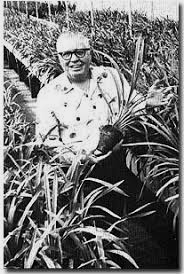
Oil was discovered, in spectacular fashion, on June 23, 1921, when a test well on Signal Hill (then an unincorporated area on the north edge of Long Beach) turned out to be a gusher. A struggling farmer in Rivera (it hadn't yet become Pico Rivera) understood the potential of this discovery. He sent away for a government pamphlet on the method of extracting oil and gasoline, borrowed $4,000 from his mother, and founded a company, Signal Oil and Gas Co., that eventually became a huge enterprise. The farmer was Samuel Barlow Mosher, born in 1892 in Carthage, NY. He had contracted polio as a child, which left him with a "withered leg" (as he wrote on his World War I draft registration form), but he was strong and resourceful. He already had a degree in agriculture from the University of California at Berkeley. He was soon to be know as "the little giant of Signal Hill".
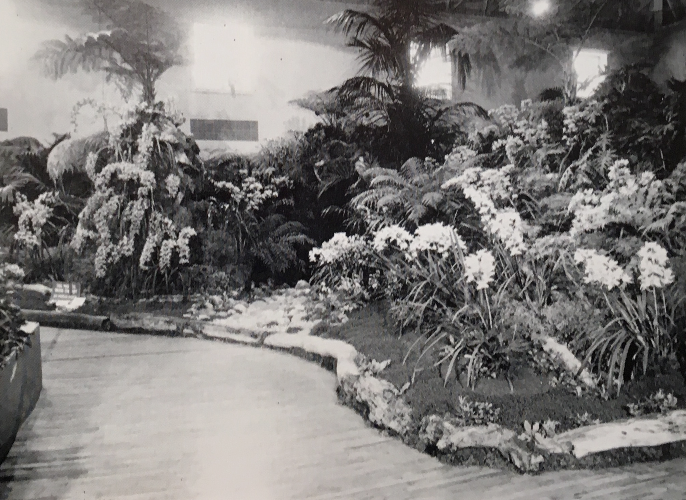
His businesses multiplied and thrived. Some of our members may remember filling up at a Signal Gas Station. In 1942, he purchased Rancho los Dos Pueblos in what is now Goleta, just up the coast from Santa Barbara. There he built up a large estate from which he could see some of his oil wells along the coast.
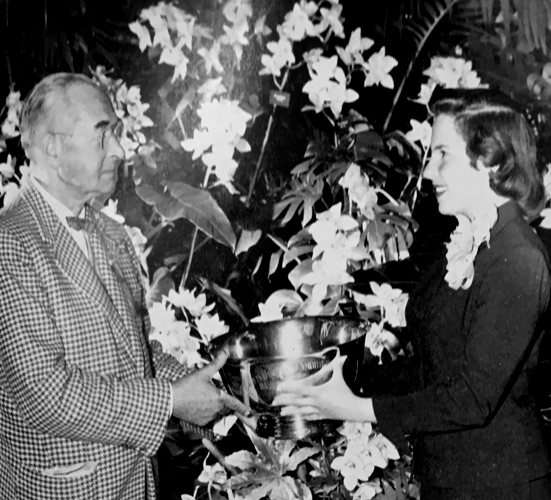
The rancho was soon in the cattle business and the nursery business. One of businesses created from the rancho was Dos Pueblos Orchid Company. In short order, he had several acres of Cymbidiums under glass. His staff developed methods for bringing Cymbidiums to market several years sooner than was the norm at the time, with numerous innovations for orchid culture and greenhouse management. The company was soon the largest orchid company in the world!
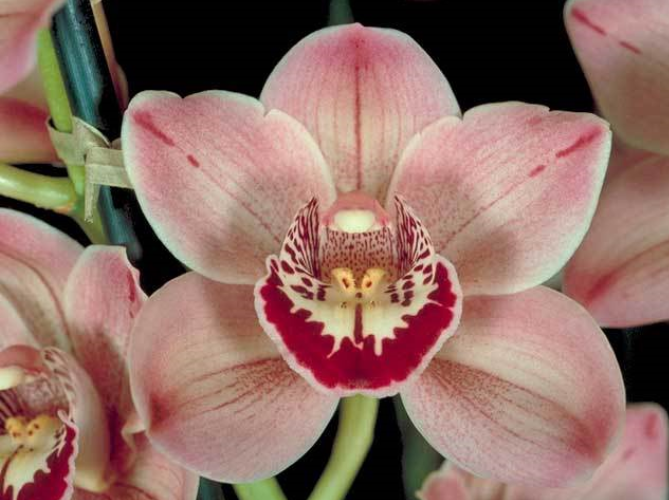
Mosher wasn't the first person to grow Cymbidiums in the Santa Barbara area. There were many amateur growers, and at least one or two nuseries were already selling Cymbidiums (notably a nursery run by Bert Kallman), but there was nothing on such a large scale. It was Dos Pueblos Orchid Company that turned orchid growing into an industry in Santa Barbara.
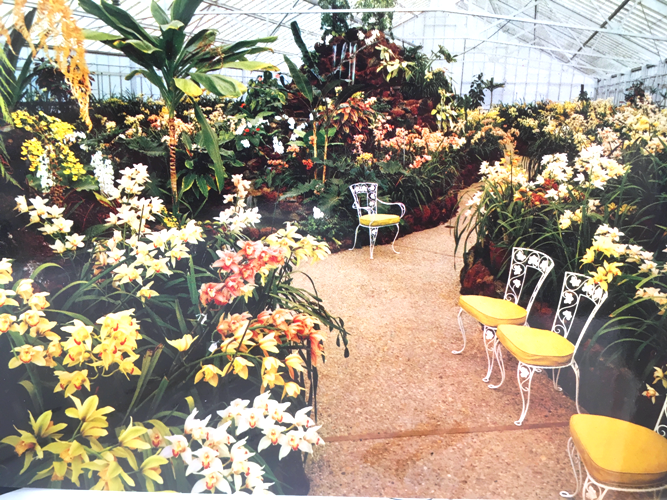
Mosher died in 1970. Dos Pueblos continued as a business perhaps as late as 1996. And that is how Signal Hill oil money created the orchid industry in Santa Barbara! Mosher's other adventures are at least as remarkable. With further research, we hope to bring you some of them.
The forest of oil derricks is long gone. You have to know where to look to get even a vague idea of what Long Beach and Signal Hill looked like during the oil boom. But there were oil wells and orchids side by side in Long Beach when South Coast Orchid Society was founded in 1950, as revealed in this account about our first president, published only a year earlier:
Orchid Digest, September-October 1949, p. 473-474:
CALLING ON PAUL N. BAKER
J. P. Spitzel
We are headed for a visit with Mr. Paul N. Baker, one of our newer members. Turning off Long Beach Boulevard at 37th Street, we are rather startled to find ourselves at the very edge of a busy oil field. Oil wells pumping, over there a typical little field office—yes, right here in the midst of it all, two greenhouses. Mr. Baker’s greenhouses are not at his residence, but right among the oil wells. At first this seems rather startling, but when Mr. Baker explained that his backyard at home is too small to indulge in his hobby, and that on the other hand he has quite a bit of time during the day to take care of his plants, it all seems rather simple.
As we expected, we found Mr. Baker repotting and he was making a splendid job of it. His hobby dates back to 1942. His first collection consisted of a dozen miscellaneous cymbidiums, seven laelias and three stray “catts.” Greenhouses were not available during the war, but there was a nice peach tree in the back yard, so the peach tree pinch-hits for a greenhouse and evidently fills the bill well. Such little inconveniences as moving all the plants into the kitchen when a cold spell was predicted did not deter nor discourage an enthusiast like Paul Baker.
Early in 1948 Mr. Baker built his first 10 × 12 greenhouse. Within a matter of months it proved too small and by November of the same year a second greenhouse, slightly larger than the first one, was erected. Now, six months later, plans are under way for another of generous size.
Overhead lath is used in lieu of whitewash. The plants look well. Mr. Baker has his own ideas on potting. He believes in ramming osmunda down real hard in the lower half or two-thirds of the pot, the balance is potted medium hard. He waters every week or ten days, soaking the material well; sprays overhead on every sunny day. He thinks that by pursuing this method of watering he can lengthen the life of the osmunda to three years instead of the usual two. In line with this thought he advocates the use of larger pots to allow for three years’ growth. Some of the mature plants and seedlings are potted in Ashton’s mix. He likes this mix so well that he is experimenting with this material by potting in a combination of half osmunca and half Ashton’s mix.
Another of his experiments is potting the plants in Yucca Cactus Fibre. The cactus fibre is a by-product of water conditioning manufacturers. He claims root action is exceptionally good. Mr. Baker is also attempting to raise the carbon dioxide contents in the air of his house by letting a layer of yucca fibre decay under his benches. He hopes to raise the CO2 to 0.04 of 1%. Normal is supposed to be 0.03 of 1%.
Whenever possible, rainwater is used for watering the plants.
Only one plant was in bloom; an unidentified seedling blooming for the first time, beautiful, dark reddish color, with five flowers.
We thanked Paul Baker for having so generously expounded his theories for the benefit of the readers of the ORCHID DIGEST and we promised to drop in sometime again soon.
Orchid Review March, 1959, p. 101
DOS PUEBLOS ORCHID CO. EXPANDS CATTLEYA DIVISION
The cattlea division of Dos Pueblos Orchid Company, Goleta, California, is now in the process of a large expansion, according to an announcement made this wekk by Kermit Hernlund, president and general manager of the firm. Dos Pueblos now produces more cymbidium orchids than any other grower in the world, and the new division for the culture of cattleyas will round out the company's orchid family, according to Hernlund.
Heading the division, and in charge of the expansion plans, is Mr. Joseph Hampton, nationally known orchid specialist, who has recently joined Dos Pueblos Orchid Company. Hampton started his career in orchid culture with Armacost and Royston in Los Angeles 30 years ago, where he began his specialization in the cattleya orchid. From there, after seven years, he joined the famed cattleya grower, Joseph W. Urmiston, where he remained for 16 years. He comes to Dos Pueblos after bing with B. O. Bracey and Co., of Santa Ana, for the past seven years. He is a member of the South Coast Orchid Society, the Hollywood Horticultural Society, the Orange County Orchid Society, is a past presiednet of the Southern California Orchid Society, an accredited American Orchid Society judge, and president of the Cymbidium Society of California. He has figured in the development of such famous crosses as Læliocattleyas Trails End and Manilla, and Cattleyas Amabilis and Labi-Royal. In 1940, with Mr. Urmiston, Hampton developed the techniche of "photo-periodism," the control of cattleya blooming periods by means of artificial light, which is now considered standard procedure.
Immediate plans for the Dos Pueblos expansion include the construction of 50,000 square feet of greenhouse space adjacent to the headquarters offices, all of which will be devoted to cattleyas. An extensive breeding programme will be started when the new houses are completed early this year. At present, Hampton is securing the finest quality stud plants in the world, preparatory to occupying the new facilities.
Notes: The correct spelling is Urmston. The correct name is Cymbidium Society of America; also Lc. Trail's End. The Cattleya breeding program resulted in at least 42 registered hybrids from Dos Pueblos, 1960-1980, some of them registered by others. However, the number of awards from this program was quite modest, as was the use of these hybrids in further crosses. Joseph Hampton died before the program could really get off the ground, in 1963. He was a much loved member of SCOS and a very important figure in the development of the cattleya industry in Southern California.